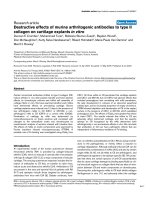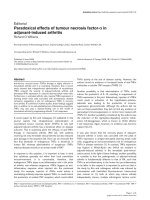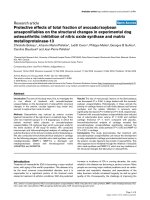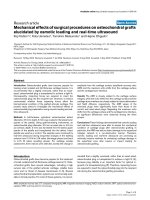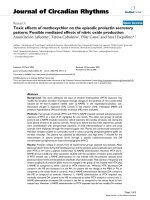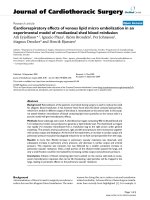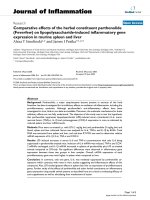Báo cáo y học: "Anti-oxidative effects of the biennial flower of Panax notoginseng against" pptx
Bạn đang xem bản rút gọn của tài liệu. Xem và tải ngay bản đầy đủ của tài liệu tại đây (725.31 KB, 7 trang )
RESEA R C H Open Access
Anti-oxidative effects of the biennial flower of
Panax notoginseng against H
2
O
2
-induced
cytotoxicity in cultured PC12 cells
Roy Chi-Yan Choi
1
, Zhiyong Jiang
1,2
, Heidi Qun Xie
1
, Anna Wing-Han Cheung
1
, David Tai-Wai Lau
1
, Qiang Fu
1
,
Tina Tingxia Dong
1
, Jijun Chen
2
, Zhengtao Wang
3
, Karl Wah-Keung Tsim
1*
Abstract
Background: Radix notoginseng is used in Chinese medicine to improve blood circulation and clotting; however,
the pharmacological activities of other parts of Panax notoginseng hav e yet to be explored. The present study
reports the anti-oxidative effects of various parts of Panax notoginseng.
Methods: Various parts of Panax notoginseng, including the biennial flower, stem-leaf, root-rhizome, fiber root and
sideslip, were used to prepare extracts and analyzed for their anti-oxidation effects, namely suppressing xanthine
oxidase activity, H
2
O
2
-induced cytotoxicity and H
2
O
2
-induced ROS formation.
Results: Among various parts of the herb (biennial flower, stem-leaf, root-rhizome, fiber root and sideslip), the
water extract of the biennial flower showed the strongest effects in (i) inhibiting the enzymatic activity of xanthine
oxidase and (ii) protecting neuronal PC12 cells against H
2
O
2
-induced cytotoxicity. Only the water extracts
demonstrated such anti-oxidative effects while the ethanol extracts did not exert significant effects in suppressing
xanthine oxidase and H
2
O
2
-induced neuronal cytotoxici ty.
Conclusions: The present study demonstrates the biennial flower of Panax notoginseng to have neuroprotection
effect on cultured neurons and the underlying protection mechanis m may involve anti-oxidation.
Background
Radix Notoginseng (Sanqi, the root of Panax notogin-
seng) is a Chinese herbal medicine used in China to pro-
mote blood circulation, remove blood stasis, induce
blood clotting, relieve swelling and alleviate pain [1,2].
Moreover, Panax notoginseng is beneficial for coronary
heart disease, cerebral vascular disease as well as learn-
ing and memory improvement [3-7]. These therapeutic
effects are attributed to its active ingredients, namely
saponins [8,9], flavonoids [10] and polysaccharides
[11,12].
Saponins isolated from Radix Notoginseng increase the
blood flow of coronary arteries [13], prevent platelet
aggregation [14], decrease oxygen consumption by heart
muscles [15], restore learning impair ment induced by
chronic morphine administration [16] and protect neu-
ronal cell death against oxidative stress [17]. Flavonoids
increase the coronary flow, reduce myocardial oxygen
consumption and lower arterial pressure [10]. A flavonol
glycoside called quercetin 3-O-b-D-xylopyranosyl-b-D-
galactopyranoside (RNFG) from the root and rhizome of
Panax notoginseng is promising in treating Alzheimer’s
disease through inhibiting amyloid-b aggregation and
amyloid-b-i nduced cytotoxicity in cortical neuron cul-
tures. Such neuroprotection effect was mediated by the
suppression of apoptosis triggered by amyloid-b [18].
Moreover, polysaccharide extracted from the root-
rhizome of Panax notoginseng is also considered to be
an active constituent with immuno-stimulating activities
in vitro [11,12,19].
While the therapeutic effects of the root of Panax
notoginseng have been demonstrated, the pharmacologi-
cal effects of other parts of Panax notoginseng are
* Correspondence:
1
Center for Chinese Medicine and Department of Biology, Hong Kong
University of Science and Technology, Clear Water Bay, Kowloon, Hong Kong
SAR, China
Full list of author information is available at the end of the article
Choi et al. Chinese Medicine 2010, 5:38
/>© 2010 Choi et al; licensee BioMed Central Ltd. This is an Open Access article distributed under the terms of the Creative Commons
Attribution License (http://creati vecommons.org/licenses/by/2.0), which permits unrestricted use, distribut ion, and reproduction in
any medium, provided the original work is properly cited.
largely unknown. The present study examines the anti-
oxidation effects of other parts of Panax notoginseng.
Methods
Plant materials and preparation
Fresh Panax notoginseng from Wenshan in Yunnan Pro-
vince (China) was identified morphologically during har-
vest. Voucher specimen (number 03-6-8) of Panax
Notoginseng was confirmed by genetic analysis [20] and
deposited at the Department o f Biology, Hong Kong
University of Science and Technology. For water extrac-
tion, the biennial flower, stem and leaf, root-rhizome,
fiber root and/or sideslip (10 g) were boiled in 80 ml of
water for two hours twice. The e xtract was then dried
by lyophilization with an extraction efficiency of 15-18%.
For ethanol extraction , biennial flower (10 g) was soni-
cated in 100 ml of 30%, 50%, 70% and 90% ethanol for
30 minutes twice. The extract was dried by rota-
evaporationat60°Cwithanextractionefficiencyof5-
8%. The water and ethanol extracts were re-dissolved in
water to 100 mg/ml stock concentration.
Cell culture
Rat pheochromatocytoma PC12 cell line was obtained
from ATCC (CRL-1721; USA). The cells were main-
tained in Dulbecco’ s modified Eagles medium ( DMEM)
supplemented with 6% fetal bovine serum and 6% horse
serum at 37°C in a water-satur ated 7.5% CO
2
incubator.
Reagents for cell cultures were purchased from Invitro-
gen Technologies (USA).
In vitro xanthine oxidase activity
Xanthine oxidase activity assay was described previously
[21]. In brief, the herbal extracts ( 0.1 mg/ml) were pre-
mixed with 0.05U/ml xanthine oxidase fo r 20 minutes.
Then 0.4 mM xanthine and 0.24 mM hydroxyl amine
were incubated for 20 minutes at 37°C. Reactions were
stopped by adding 0.1% SDS to the mixture and mea-
sured at 550 nm absorbance. Vitam in C at various con-
centrations (0, 17.6, 35.2, 52.8 and 88 μg/ml)servedas
the positive cont rol of anti-oxid ation. All the chemicals
were purchased from Sigma (USA).
Cell viability test
Cultured PC12 cells in 96-well-plate (5000 cells/well)
were pre-treated with various extracts (1 mg/ml) for 24
hours. After washed with PBS and replaced by fresh cul-
ture medium, the cultures were treated with 13.6 μg/ml
hydrogen peroxide (H
2
O
2
) for 24 hours. Cell viability
test was performed with the addition of thiazolyl blue
tetrazolium bromide (MTT) (Sigma, USA) in PBS at a
final concentrat ion of 5 mg/ml for four hours. After the
solution was removed, the purple precipitate inside the
cells was re-suspended in DMSO and then measured at
570 nm absorbance [22]. H
2
O
2
at various concentrations
(0,1.7,3.4,6.8and13.6μg/ml)servedasacontrolfor
the cytotoxicity test.
Determination of ROS formation
The reactive oxygen species (ROS) level in cell cultures
was determined according to the method by Zhu et al.
[22]. Cultured PC12 cells in 96-well-plate were pre-
treated with the water and ethanol extracts of biennial
flower (1 mg/ml) for 24 hours, and then the cells were
labeled by 100M dichlorofluorescin diacetate (DCFH-
DA, Sigma, USA) in HBSS for one hour at 25°C. Cul-
tures were treated with 13.6 μg/ml H
2
O
2
for one hour.
The amount of intracellular H
2
O
2
-induced ROS was
detected by fluorometric measurement with excitation
at 485 nm and emission at 530 nm (SPECTRA max®
GEMINI XS, Molecular Devices Corporation, USA).
Statistical analysis
Individual data were expressed as mean ± standard
deviation (SD). A post-hoc Dunnett’ stestwasusedto
obtain corrected P values in group comparisons. Statisti-
cal analyses were performed with one-way ANOVA
(version 13.0, SPSS, USA). Data were considered as sig-
nificant when P < 0.05 and highly significant when P <
0.001.
Results
Anti-oxidative effects of Panax notoginseng’s biennial
flower
To reveal the anti-oxidative effects of Panax notogin-
seng, we carried out an in vitro assay of xanthine oxidase
effects. The abnormality of the xanthine oxidase causes
pathological disorders [23-25]; thus, the enzyme is a bio-
logical marker for anti-oxidative effects. In the presence
of vitamin C at various concentrations (0, 17.6, 35.2,
52.8 and 88 μg/ml), xanthine oxidase effects were sup-
pressed in a dose-dependent manner, with maximum
inhibition of 80% as compared with the control (Figure
1A), validating this anti-oxidation assay. Different parts
of Panax notoginseng including the biennial flower,
stem-leaf, root-rhizome, fiber root and sideslip were
separated from the whole plant (Figure 2) and subjected
to water extraction. Individual extract was tested on its
anti-oxidation effects against xanthine oxidase. Water
extract (0.1 mg/ml) from the biennial flower possessed
the st rongest anti-oxidative effects ( about 80% of
enzyme inhibition) among various parts of Panax noto-
ginseng while the extract from sideslip showed the least
effects (Figure 1B). Vitamin C (35.2 μg/ml)servedasa
positive control with an inhibition rate of about 70%.
These results suggested that different parts of Panax
notoginseng all possessed anti-oxidative effects with vary-
ing degrees.
Choi et al. Chinese Medicine 2010, 5:38
/>Page 2 of 7
The above in vitro anti-oxidative effects of Panax
notoginseng could be mediated by a direct interaction
between the herb-derived active ingredient(s) and
xanthine oxidase. H owever, we speculate that such
interaction may not be allowed inside the cell because
the cell permeability and cellular absorption of the
active ingredients are unknown. For this reason, a cell-
based assay using neuronal PC12 cell was employed.
PC12 cell is a popular study model in analyzing the neu-
roprotective effects against o xidation and other insults
[22,26,27]. To inducing oxidative stress, we treated the
cultures with various concentrations of H
2
O
2
(0-13.6
μg/ml) and assayed for their cell viability. The neuronal
cytotoxicity of PC12 cells induced by H
2
O
2
was demon-
strated by a dose-dependent decrease of cell viability
(Figure 3A). At 13.6 μg/ml concentration of H
2
O
2
,
about 50% cells survived. Under such cytotoxic condi-
tion, pre-treatment of the extracts from the biennial
flower, stem-leaf and rhizome (1 mg/ml) protected
PC12 cells against H
2
O
2
insult (Figure 3B). Among all
the tested extracts, the neuroprotective effects of the
biennial flower were more robust than those of stem-
leaf and rhizome. On the other hand, the extract of
fiber root did not show any significant response while
the sideslip was no t included due to its negative effects
in anti-oxidation. Pre-treatment of vitamin C was per-
formed in control. These results showed that the water
extract of the biennial flower of Panax notoginseng
exhibited significant anti-oxidative effects.
Comparison of anti-oxidative effects by water and
ethanol extracts
To reveal the importance of solvent selection, we used
various concentrations of ethanol (30%, 50%, 70% and
90%) in the extraction of the biennial flower. The anti-
oxidative effects of the ethanol extracts (0.1 mg/ml)
were compared with those of water extraction.The etha-
nol extracts of the biennial flower showed lesser anti-
oxidative effects (Figure 4); both 30% and 90% ethanol
extracts exerted about 18% inhibition whereas 50%
Figure 1 In vitro anti-oxidative effects of extracts from various
parts of Panax notoginseng. A: Vitamin C at various
concentrations (0, 17.6, 35.2, 52.8 and 88 μg/ml) was pre-incubated
with xanthine oxidase before the addition of the xanthine substrate.
The xanthine oxidase activity was measured at 550 nm absorbance.
B: Extracts (0.1 mg/ml) from the biennial flower, stem-leaf, rhizome
and fiber root of Panax notoginseng were assayed for their anti-
xanthine oxidase activity as in [A]. Vitamin C (35.2 μg/ml) served as
positive control. Data were expressed as% of inhibition where all
the values were normalized by the control (no drug treatment),
Mean ± SD, n = 6. Statistical significance is indicated as ** P =
0.00876 for biennial flower vs stem-leaf; and *** P = 0.000586 for
biennial flower vs root-rhizome.
Figure 2 A schematic diagram to illustrate various parts of
Panax notoginseng.
Choi et al. Chinese Medicine 2010, 5:38
/>Page 3 of 7
ethanol extract did not show inhibition at all. Vitamin C
served as positive control. Moreover, the neuroprotec-
tive effects of the ethanol extracts were tested in cul-
tured PC12 cells. Pre-treatments of 50%, 70% and 90%
ethanol extracts did not protect the neuronal cultures
against H
2
O
2
-induced cell death (Figure 5A) while 30%
ethanol extract slightly exerted neuroprotective effects.
The water e xtract performed the best. To further con-
firm the anti-oxidative effects of the water extract in
PC12 cells, we pre-treated the cultures with various
water extracts (0.01-10 mg/ml) and then with H
2
O
2
and
performed cell viability assay. The survival rate of PC12
cells under H
2
O
2
insult was improved in a dose-depen-
dent manner (Figure 5B). The saturation dose was at
about 1 mg/ml. Therefore, water extracts of the biennial
flo wer showed stronger anti-oxidative effects than etha-
nol extracts.
To elucidate t he anti-oxidative mechanism of the
biennial flower, we chose reactive oxygen species (ROS)
for the investigation because ROS promote the oxidation
of lipid, protein and DNA, thereby affecting the normal
cell physiology, leading to neuronal demise [28,29]. Cul-
tured PC12 cells were pre-labeled with an ROS indicator
and then treated with various concentrations of H
2
O
2
(0-400 μM). Upon the addition of H
2
O
2
, ROS formation
increased in a dose-dependent manner (Figure 6A).
Such elevation of ROS in cultured PC12 cells was
Figure 3 Anti-oxidative effects by the extract of the biennial
flower of Panax notoginseng against H
2
O
2
-induced cytotoxicity
in PC12 cells. A: Various concentrations of H
2
O
2
(0, 1.7, 3.4, 6.8 and
13.6 μg/ml) were added onto cultured PC12 cells, incubated for 24
hours and determined with cell viability assay. B: Extracts (1 mg/ml)
from biennial flower, stem-leaf, rhizome and fiber root of Panax
notoginseng were pre-treated with PC12 cells for 24 hours before
the addition of H
2
O
2
(13.6 μg/ml) for cytotoxicity test as in [A].
Vitamin C (35.2 μg/ml) served as a positive control. Data were
expressed as% of control where the value of untreated culture was
set as 100%, Mean ± SD, n = 4. Statistical significance is indicated as
* P = 0.0412 for root-rhizome vs control); ** P = 0.00826 for biennial
flower vs root-rhizome and *** P = 0.000215 for biennial flower vs
control.
80
60
ase
)
Xanthine oxida
( % of inhibition
40
20
0
Extract of biennial flower
***
***
***
*
Figure 4 Comparison of anti-xanthine oxidase effects between
the water- and ethanol-extracts of the biennial flower. Biennial
flower of Panax notoginseng was extracted by water or various
concentrations of ethanol (30, 50 70 and 90%). Extracts (0.1 mg/ml)
were tested for their anti-oxidative effects against xanthine oxidase
as in Figure 1. Vitamin C (35.2 μg/ml) served as positive control.
Data were expressed as% of inhibition where all the values were
normalized by the control (no drug treatment), Mean ± SD, n =6.
Statistical significance is indicated as * P = 0.0419 for control
(without extract) vs 70% EtOH and *** P = 0.0000852 for control
(without extract) vs water, P = 0.000725 for control (without extract)
vs 30% EtOH and P = 0.000897 for control (without extract) vs 90%
EtOH.
Choi et al. Chinese Medicine 2010, 5:38
/>Page 4 of 7
reduced by the pre-treatment of water extract of the
biennial flower, with about 30% ROS inhibition (Figure
6B). By contrast, 30% ethanol extract slightly reduced
the amount of H
2
O
2
-induced ROS whereas 50%, 70%
and 90% of ethanol extracts did not show any effects.
Discussion
The present study, for the first time, demonstrated the
anti-oxidative effects possessed by the water extract of
the biennial flower of Panax notoginseng through the
suppression of H
2
O
2
-induced ROS formation and
neuroprotection against H
2
O
2
insult. More importantly,
it was the biennial flower instead of the root-rhizome
that showed the strongest effects. These results support
the multi-functional roles of Panax notoginseng and
warrant further studies to explore other pharmacological
effects of the plant. In terms of identifying the possible
ility
rol )
100
+ H
2
O
2
-H
2
O
2
***
*
A
Cell viabi
( % of cont
80
60
40
20
0
Extract of biennial flower
Pre-treatment:
B
Cell viability
% of protection )
100
80
60
40
+ H
2
O
2
B
C
(
20
0
0.01
Pre-treatment of water extract
of biennial flower
( mg/ml )
0.1 1 10
Figure 5 Dose-dependent effects of the water extract of the
biennial flower against H
2
O
2
-induced cytotoxicity in PC12 cells.
A: Extracts (1 mg/ml) of biennial flower by water and ethanol
extractions were pre-treated with PC12 cells for 24 hours before the
addition of H
2
O
2
(13.6 μg/ml) for cytotoxicity test as in Figure 2.
Vitamin C (35.2 μg/ml) served as positive control. B: Dose-
dependent response was performed by pre-treating the culture
with various concentrations of the water extract of the biennial
flower (0.01-10 mg/ml). Data were expressed as% of control where
the value of untreated culture was set as 100%, Mean ± SD, n =4.
Statistical significance is indicated as * P = 0.00471 for control
(without extract) vs 30% EtOH and *** P = 0.000693 for control
(without extract) vs water.
Figure 6 Suppression of the formation of H
2
O
2
-induced ROS
formation in PC12 cells by water extracts of the biennial
flower. A: Cultured PC12 cells were pre-labeled DCFH-DA for one
hour before the addition of various concentrations of H
2
O
2
(0, 1.7,
3.4, 6.8 and 13.6 μg/ml) for another hour. The amount of ROS was
fluorometrically measured with excitation at 485 nm and emission
at 530 nm. B: Water and ethanol extracts of the biennial flower (1
mg/ml) were pre-treated with the PC12 cells for 24 hours. H
2
O
2
(13.6 μg/ml) was used in the ROS formation assay as in A. Vitamin C
(35.2 μg/ml) served as positive control. Data were expressed as% of
inhibition where all the values were normalized by the control (no
drug treatment), Mean ± SD, n = 4. Statistical significance is
indicated as * P = 0.00419 for control (without extract) vs 30% EtOH
and *** P = 0.000269 for control (without extract) vs water.
Choi et al. Chinese Medicine 2010, 5:38
/>Page 5 of 7
active ingredient(s) from the biennial flower, the anti-
oxidation effects of different ethanol extracts were
shown to be significantly less potent than that of the
water extract, suggesting that the majority of active
compounds might be preferentially water soluble. How-
ever, a continuous work of activity-guided fractionation
is required to purify and identify the candidates from
the water extract of biennial flower. In this case, the
high solubility of those act ive compounds in water will
facilitate the preparation of health food supplements
and drinks that could be developed from the biennial
flower. Indeed, this new application will increase the
economic value of Panax notoginseng.
Neuronal action of Panax not oginseng on the brain
possesses various aspects. Saponins derived from the
herb have been shown to prevent the neuronal cell
death against hypoxia condition. The mechanism was
related to the improvement of energy metabolism [30].
The therapeutic effect of saponins derived from Panax
notoginseng was further supported by promoting the
absorption of hematoma in hemorrhagic apoplexy at
super-early stage in rat [31], and protecting the neuron
against insults and promoting functional rehabilitation
in patients after cerebral hemorrhage [32]. In addition,
the co-treatment of ic ariin and sponins derived fro m
Panax notoginseng exerted significant prophylactic and
therapeutic effects in rat models of Alzheimer’sdisease
in vivo [33], as well as ameliorated the learning and
memory deficit and blood viscosity by protecting neu-
rons from oxidative stress in ischemic brain [34]. For
neurotrophi c effects, the phosphorylated neurofilament-
and MAP2-expressing neurites could be extended in
SK-N-SH cells by the treatment of saponins and Panax
notoginseng extracts, suggesting the possible axonal and
dendritic formation activity [35]. Therefore, the multi-
functional effects of saponins from Panax notoginseng
might be a good candidate in mediating the anti-
oxidation activities because of the high extractability of
saponins by water. This speculation was in accordance
to our previous finding that the amounts of four active
constituents, notoginsenoside R
1
,ginsenosideR
g1
,R
b1
and R
d
, by water extraction were higher than that of
30% and 70% ethanol extractions [36]. In addition to
saponins, a flavonol glycoside, named RNFG, isolated
from Panax notoginseng also possesses the neuroprotec-
tive effect against amyloid-b-induced apoptosis and
cytotoxicity at cellular level, and which improves the
learning and memory process in rats [18]. Interestingly,
this compound also exerts a sig nificant anti-oxidative
activity by lowering the amount of reactive oxygen spe-
cies (ROS) induced by H
2
O
2
in cultured PC12 cells.
Based on the above findings, it should be very interest-
ing to know if the bie nnial flower contains RNFG, and
which could have neuroprotective effect in cell cultures
and in animal study. Therefore, the identification and
isolation of the possible active ingredients (saponins, fla-
vonoids, flavonol glycoside or others) will be essential to
extend and support the multi-functional usages of Radix
Notoginseng in future.
Conclusion
The present study demonstrates the biennial flower of
Panax notoginseng to have neuroprotection effect on
cultured neurons and the underlying protection
mechanism may involve anti-oxidation.
Abbreviations
CO
2
: carbon dioxide; DCFH-DA: dichlorofluorescin diacetate; DMEM:
Dulbecco’s modified eagle medium; DMSO: dimethyl sulfoxide; H
2
O
2
:
hydrogen peroxide; HPLC: high performance liquid chromatography; MTT: 3-
(4,5)-dimethylthiahiazo (-z-y1)-3,5-di- phenytetrazoliumromide; PBS:
phosphor-buffer saline; RNFG: 3-O-b-D-xylopyr anosyl-b-D-galactopyranoside;
ROS: reactive oxygen species; SDS: sodium dodecyl sulfate
Acknowledgements
This research was supported by grants from the University Grants
Committee (AoE/B-15/01), Research Grants Council of Hong Kong (HKUST
6419/06M, 662608, N_HKUST629/07) and Croucher Foundation (CAS-CF07/
08.SC03) to KWKT.
Author details
1
Center for Chinese Medicine and Department of Biology, Hong Kong
University of Science and Technology, Clear Water Bay, Kowloon, Hong Kong
SAR, China.
2
State Key Laboratory of Phytochemistry and Plant Resources in
West China, Kunming Institute of Botany, Chinese Academy of Sciences,
Kunming, Yunnan 650204, China.
3
Institute of Chinese Materia Medica,
Shanghai University of Traditional Chinese Medicine, 1200 Cailun Road,
Zhangjiang Hi-Tech Park, Shanghai 201203, China.
Authors’ contributions
TTXD, JJC, ZTW and KWKT designed the experiments. RCYC, ZYJ, HQX,
AWHC, DTWL and QF conducted the experiments. All authors read and
approved the final version of the manuscript.
Competing interests
The authors declare that they have no competing interests.
Received: 5 April 2010 Accepted: 28 October 2010
Published: 28 October 2010
References
1. Lei XL, Chiou GC: Cardiovascular pharmacology of Panax notoginseng
(Burk) F.H. Chen and Salvia miltiorrhiza. Am J Chin Med 1986, 14:145-152.
2. Cicero AF, Vitale G, Savino G, Arlett R: Panax notoginseng (Burk.) effects on
fibrinogen and lipid plasma level in rat fed on a high-fat diet. Phytother
Res 2003, 17:174-178.
3. Zheng GZ, Yang CR: Biology of Panax Notoginseng and Its Application
Beijing: Science Press 1994.
4. Zheng XY, (ed.): Pharmacopoeia of the People’s Republic of China Beijing:
Chemistry Industry Press 2000.
5. Chan P, Thomas GN, Tromlinson B: Protective effects of trilinolein
extracted from Panax notoginseng against cardiovascular disease. Planta
Med 2002, 68:1024-1028.
6. Kim HC, Shin EJ, Jang CG, Lee MK, Eun JS, Hong JT, Oh KW:
Pharmacological action of Panax ginseng on the behavioral toxicities
induced by psychotropic agents. Arch Pharm Res 2005, 28:995-1001.
7. Chuang CM, Hsieh CL, Lin HY, Lin JG: Panax notoginseng Burk attenuates
impairment of learning and memory functions and increases ED1, BDNF
and beta-secretase immunoreactive cells in chronic stage ischemia-
reperfusion injured rats. Am J Chin Med (Gard City N Y) 2008, 36:685-693.
Choi et al. Chinese Medicine 2010, 5:38
/>Page 6 of 7
8. Wu W, Zhang XM, Liu PM, Li JM, Wang JF: Effects of Panax notoginseng
saponin R
g1
on cardiac electrophysiological properties and ventricular
fibrillation threshold in dogs. Acta Pharm Sin 1995, 16:459-463.
9. Chen JC, Chen LD, Tsauer W, Tsai CC, Chen BC, Chen YJ: Effects of
Ginsenoside R
b2
and R
c
on inferior human sperm motility in vitro. Am J
Chin Med (Gard City N Y) 2001, 29:155-160.
10. Wei JX, Wang JF, Chang LY, Du YC: Chemical studies of san-chi Panax
notoginseng I: Studies on the constituents of San-Chi root hairs. Acta
Pharm Sin 1980, 15:359-364.
11. Gao H, Wang F, Lien EJ, Trousdale MD: Immunostimulating
polysaccharides from Panax notoginseng. Pharm Res 1996, 13:1196-1200.
12. Wu Y, Wang D: Structural characterization and DPPH radical scavenging
activity of an arabinoglucogalactan from Panax notoginseng root. J Nat
Prod 2008, 71:241-245.
13. Huang YS, Yang ZC, Yan BG, Hu XC, Li AN, Crowther RS: Improvement of
early postburn cardiac function by use of Panax notoginseng and
immediate total eschar excision in one operation. Burns 1999, 25:35-41.
14. Wang J, Xu J, Zhong JB: Effect of Radix Notoginseng saponins on platelet
activating molecule expression and aggregation in patients with blood
hyperviscosity syndrome. Zhongguo Zhong Xi Yi Jie He Za Zhi 2004,
24:312-316.
15. Chen ZH, Wang DC, Li HL, Wei JX, Wang JF, Du YC: Hemodynamic effects
of san chi (Panax notoginseng) root, leaf, flower and saponins on
anesthetized dogs. Acta Pharm Sin 1983, 18:818-822.
16. Qi D, Zhu Y, Wen L, Liu Q, Qiao H: Ginsenoside R
g1
restores the
impairment of learning induced by chronic morphine administration in
rats. J Psychopharmacol 2009, 231:74-83.
17. Bao HY, Zhang J, Yeo SJ, Myung CS, Kim HM, Kim JM, Park JH, Cho J,
Kang JS: Memory enhancing and neuroprotective effects of selected
ginsenosides. Arch Pharm Res 2005, 28:335-342.
18. Choi RC, Zhu JT, Leung KW, Chu GK, Xie HQ, Chen VP, Zheng KY, Lau DT,
Dong TT, Chow PC, Han YF, Wang ZT, Tsim KW: A flavonol glycoside,
isolated from roots of Panax notoginseng, reduces amyloid-beta-induced
neurotoxicity in cultured neurons: signaling transduction and drug
development for Alzheimer’s disease. J Alzheimers Dis 2010, 19:795-811.
19. Ohtani K, Mizutani K, Hatono S, Kasai R, Sumino R, Shiota T, Ushijima M,
Zhou J, Fuwa T, Tanaka O: Sanchinan-A, a reticuloendothelial system
activating arabinogalactan from sanchi-ginseng (roots of Panax
notoginseng). Planta Med 1987, 53:166-169.
20. Cui XM, Lo CK, Yip KL, Dong TT, Tsim KW: Authentication of Panax
notoginseng by 5S-rRNA spacer domain and random amplified
polymorphic DNA (RAPD) analysis. Planta Med 2003, 69:584-586.
21. Li SP, Zhao KJ, Ji ZN, Song ZH, Dong TT, Lo CK, Cheung JK, Zhu SQ,
Tsim KW: A polysaccharide isolated from Cordyceps sinensis, a traditional
Chinese medicine, protects PC12 cells against hydrogen peroxide-
induced injury. Life Sci 2003, 73:2503-2513.
22. Zhu JT, Choi RCY, Chu GK, Cheung AW, Gao QT, Li J, Jiang ZY, Dong TT,
Tsim KW: Flavonoids possess neuroprotective effects on cultured
pheochromocytoma PC12 cells: a comparison of different flavonoids in
activating estrogenic effect and in preventing beta-amyloid-induced cell
death. J Agric Food Chem 2007, 55:2438-2445.
23. Aruoma OI, Bahorun T, Jen LS: Neuroprotection by bioactive components
in medicinal and food plant extracts. Mutat Res 2003, 544:203-215.
24. Bonomini F, Tengattini S, Fabiano A, Bianchi R, Rezzani R: Atherosclerosis
and oxidative stress. Histol Histopathol 2008, 23:381-390.
25. Förstermann U: Oxidative stress in vascular disease: causes, defense
mechanisms and potential therapies. Nat Clin Pract Cardiovasc Med 2008,
5:338-349.
26. Tabakman R, Jiang H, Shahar I, Arien-Zakay H, Levine RA, Lazarovici P:
Neuroprotection by NGF in the PC12 in vitro OGD model: involvement
of mitogen-activated protein kinases and gene expression. Ann N Y Acad
Sci 2005, 1053:84-96.
27. Li SP, Zhang GH, Zeng Q, Huang ZG, Wang YT, Dong TT, Tsim KW:
Hypoglycemic activity of polysaccharide, with antioxidation, isolated
from cultured
Cordyceps mycelia. Phytomedicine 2006, 13:428-433.
28. Behl C, Moosmann B: Antioxidant neuroprotection in Alzheimer’s disease
as preventive and therapeutic approach. Free Radic Biol Med 2002,
33:182-191.
29. Perez-Pinzon MA, Dave KR, Raval AP: Role of reactive oxygen species and
protein kinase C in ischemic tolerance in the brain. Antioxid Redox Signal
2005, 7:1150-1157.
30. Jiang KY, Qian ZN: Effects of Panax notoginseng saponins on posthypoxic
cell damage of neurons in vitro. Zhongguo Yao Li Xue Bao 1995,
16:399-402.
31. Nie YX, Wang D, Zhang X: Effect of panax notoginseng saponins injection
on brain edema in intracerebral hemorrhage rats. Zhongguo Zhong Xi Yi
Jie He Za Zhi 2006, 26:922-925.
32. Wei SG, Meng LQ, Huang RY: Effect of Panax notoginseng saponins on
serum neuronal specific enolase and rehabilitation in patients with
cerebral hemorrhage. Zhongguo Zhong Xi Yi Jie He Za Zhi 2007,
27:159-162.
33. Xiao XF, Zheng M, Qu LH, Lou YJ: Effects of icariin combined with the
Panax notoginseng saponins on behavior and acetylcholinesterase
activity induced by β-amyloid peptide 25-35 lateral ventricle injection in
rats. Chin J MAP 2005, 22:178-181.
34. Zheng M, Qu L, Lou Y: Effects of icariin combined with Panax
notoginseng saponins on ischemia reperfusion-induced cognitive
impairments related with oxidative stress and CA1 of hippocampal
neurons in rat. Phytother Res 2008, 22:597-604.
35. Tohda C, Matsumoto N, Zou K, Meselhy MR, Komatsu K: Axonal and
dendritic extension by protopanaxadiol-type saponins from ginseng
drugs in SK-N-SH cells. Jpn J Pharmacol 2002, 90:254-262.
36. Dong TT, Zhao KJ, Huang WZ, Leung KW, Tsim KW: Orthogonal array
design in optimizing the extraction efficiency of active constituents
from roots of Panax notoginseng. Phytother Res 2005, 19:684-688.
doi:10.1186/1749-8546-5-38
Cite this article as: Choi et al.: Anti-oxidative effects of the biennial
flower of Panax notoginseng against H
2
O
2
-induced cytotoxicity in
cultured PC12 cells. Chinese Medicine 2010 5:38.
Submit your next manuscript to BioMed Central
and take full advantage of:
• Convenient online submission
• Thorough peer review
• No space constraints or color figure charges
• Immediate publication on acceptance
• Inclusion in PubMed, CAS, Scopus and Google Scholar
• Research which is freely available for redistribution
Submit your manuscript at
www.biomedcentral.com/submit
Choi et al. Chinese Medicine 2010, 5:38
/>Page 7 of 7


